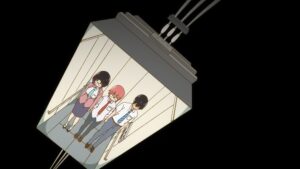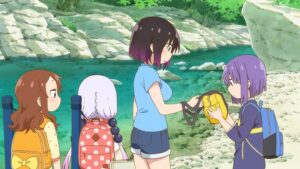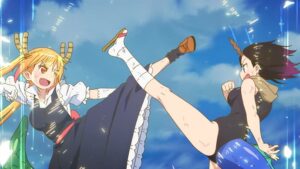This is it – this is the Maidragon I’ve been missing. These two episodes were a potpourri of workplace comedy, dragon combat, intergenerational bonding, and concentrated optimism that left me grinning after each of their miniature stories. I won’t touch on all of them in this post, but each one was a worthy addition to the show’s already-stacked collection of vignettes. If you’ve fallen behind on this season, or simply found yourself too busy to start it up, this doubleheader is the perfect reason to hop aboard the Kobayashi-san Express once again.
Episode 9 was the Elma episode, and its first segment returned us to her programming job in a way that felt particularly meaningful, given all the dialogue that surrounds overwork in today’s animation industry. Elma hit a series of comedic brick walls as she railed against her company’s exploitative labor practices, but she also encountered resistance from Kobayashi – a coworker who recognized the merit of her grievances, but maintained the quintessentially Japanese attitude of “It can’t be helped.” There’s a new breed of anime fan out there that values news on animator working conditions as much as anime itself, and I can only imagine how baffled they must have been to hear such fence-sitting coming from a KyoAni script. In fact, Elma’s quest to get people out the door on time was so strictly scheduled that her proposed solutions eliminated worker autonomy altogether. All the while, Kobayashi issued middle of the road statements like “Our company has made solid improvements since its founding,” and “I just can’t relax if I haven’t worked at least eight hours.” I found the competing attitudes in this chapter to be fascinating, since a Western viewer might expect one side of this argument to be the intended message, but Maidragon seemed to favor the other one.
It pains me to breeze past the rest of the Elma’s major appearances (especially the ultra-technical animation showcase of her fight with Tohru), but we have to talk about the high point of episode 10: Kanna’s trip to the Big Apple. I’m no New Yorker, but I’ve visited its capital several times in my life, and the layouts in this story struck me with the desire to return. From the obvious touchpoint of Times Square to lesser-known landmarks like the Bethesda Fountain, the backgrounds on display here were carefully referenced, and the abundance of fully-animated crowd members provided the hustle and bustle required of New York City. Even the dingy back streets where Kanna encountered her new friend Chloe felt quintessentially New York. Did Chloe’s kidnapping plot rank highly on the ham and cheese scale? Yes, but her reticence to return home overlapped so perfectly with Kanna’s that I could have forgiven any number of evil henchmen in exchange. The girls’ fun day in the city was magical, but underneath the sightseeing and skateboarding ran a current of homesickness that made their eventual returns just as satisfying. This was a wholly enjoyable and authentic segment – the next time I hear about a dragon sighting in NYC, I’ll be hard-pressed to dismiss it as a fairy tale.
Kanna played a big role in episode 10’s second and final story, as well, about a hot summer day with nothing to do. I think I prefer Maidragon when it administers single or double doses, rather than the three-part format we’ve gotten for much of this season. They allow the viewer to sink a bit more into each self-contained chapter, which was especially important in this one. I can imagine some fans getting restless during the opening scenes of Kanna and Kobayashi laying about the apartment, staring at the TV and idly scratching themselves, but I love that kind of relaxed atmosphere, especially as a prologue to an adventuresome stroll around town. Kanna’s childlike curiosity and Kobayashi’s patient supervision make them one of this series’ best pairings, making the former’s mapping of manhole covers a highly entertaining watch. As a gentle shower broke through the heat wave and sent them scurrying for cover, the camera meditated on the rain: water flowing into a grate, raindrops pelting a child’s swing, a ladybug rescued from drowning by Kanna’s tender hand. As the spotted insect extended its wings and flew away, Kobayashi noted that it was headed home, forming a lovely parallel with Kanna’s homecoming from the previous story.
Fifteen years of watching Japanese animation has taught me that personal preferences are not to be pitied or disparaged. People approach anime for different reasons, be it a thirst for highly-imaginative action, an interest in foreign perspectives, a fetishistic streak, a particular set of aesthetic sensibilities – the list stretches ever onward. None of these motives is inherently more or less worthy than any other, so to say “it’s a shame” that a viewer doesn’t appreciate a particular slice of the anime pie is misguided. That is my firm belief. But of all the series I’ve watched in recent years, few have come closer to pulling those three words from my lips than Miss Kobayashi’s Dragon Maid. There is so much to value here, particularly in the quiet, reflective spaces that the show carves for itself, that millions of fans will never experience due to their own preconceptions. There’s nothing wrong with avoiding the show for its cute art style or its dips into perversion or its lack of narrative thrust – those are choices that viewers should be free to make without judgment. Still, in the wake of these excellent episodes, even if I don’t type those three words out letter by letter, you had better believe I’m thinking them.








